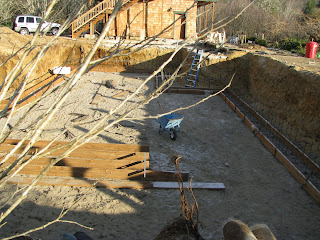
For the last several years, we have been preparing for the big project, building our dream house. We began with a doublewide, a garage, and 40 acres of brambles and fenced fields. We have cleared about two miles of rusty barbed wire. Ed has poisoned about three acres of blackber ry vines. We have built a beautiful barn, a henhouse, a garden, and as a preview for the house, a beautiful apartment over garage. The garage has been transformed from a standard three car garage with primered roll up doors, to a lovely apartment. The doublewide has been sold and moved out in preparation for the house construction.
ry vines. We have built a beautiful barn, a henhouse, a garden, and as a preview for the house, a beautiful apartment over garage. The garage has been transformed from a standard three car garage with primered roll up doors, to a lovely apartment. The doublewide has been sold and moved out in preparation for the house construction.
 ry vines. We have built a beautiful barn, a henhouse, a garden, and as a preview for the house, a beautiful apartment over garage. The garage has been transformed from a standard three car garage with primered roll up doors, to a lovely apartment. The doublewide has been sold and moved out in preparation for the house construction.
ry vines. We have built a beautiful barn, a henhouse, a garden, and as a preview for the house, a beautiful apartment over garage. The garage has been transformed from a standard three car garage with primered roll up doors, to a lovely apartment. The doublewide has been sold and moved out in preparation for the house construction.It was killing Ed to finish detailing the interior of the apartment, because his brain was already building the foundation for the house.
He had the basement excavated several days after the doublewide was moved out, so the giant hole sat for several weeks before he could start forming the the footings. He and the neighbor, Taylor, worked out in the cold, bending and tying rebar together, putting out forming stakes, checking level, checking square, getting everything together.
Then everything froze solid. For days.
Who knew you could break a pickaxe on frozen ground? Or that driving steel forming stakes would be harder than prying a snickers bar away from a diehard dieter?


Now you can't pour concrete when the ground is frozen. Ed had to wait until the ground thawed. That's when two things happened: 1. Huge chunks of the side of the dig began to let loose and fell in against the footings, knocking them totally askew, and 2. Everything surrounding the jobsite turned into adobe clay soup. It was horrible.
By omitting the description of a lot of really hard work, and by a lot of frantic prayers, the footings finally got poured and finished. The next days the forms came off. It really felt like the first significant step toward the new house.
After a lot of thought and computer searching, Ed decided to go with the insulated concrete foundation (ICFs) blocks for the foundation walls. We went and talked to some folks nearby who are using them.
"They're just like legos!", they said. "Just stack them right on top of each other."
Well..ok..but at our age, we're more familiar with Lincoln Logs or an Erector set.

They came off the truck fairly easily and down into the basement pit without a problem. Ed and Taylor started stacking them around the perimeter. With a minimal learning curve, it started to take shape right away.
With the cold winter weather, Ed ran into a little lego problem he hadn't anticipated. Frost and ice formed on top of the uppermost row, inside the "teeth" of the ICFs, where the next row fits down, preventing a snug seal.
Any source of heat (heat gun etc.) hot enough to melt the ice also melts the styrofoam. Ed tried pouring hot water over the ice only to have it refreeze before they could get the next row glued and fitted. As a last resort, Ed and Taylor hand-chipped the ice out of each tiny groove prior to placing the next piece. It was cold, ugly work!
Once the fourth row was up, it was time to do some bracing and set up scaffolding. The basement walls will be 6 1/2 blocks high, which means for the last row, each block will have to be cut in half.
The weatherman says rain for the next two days, and New Year's Day is Friday, so we may not see cement until the first of next week.
.jpg)





No comments:
Post a Comment